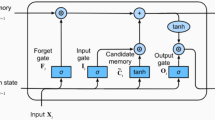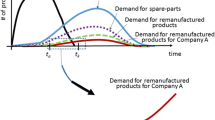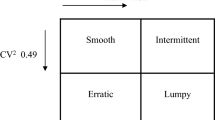Abstract
Forecasting intermittent demand for electric power materials is crucial for electric power companies to ensure the economical supply of electricity in terms of stock and cost management. This paper proposes an integrated approach to forecasting intermittent demand for electric power materials. The approach decomposes the demand time series into two parts: a binary time series representing demand occurrences and a series representing non-zero demands. From the perspective of the origin of demands, we forecast demand occurrences by both intrinsic and extrinsic factors. The probability of demand occurrence due to intrinsic factors is estimated by using the data of ontology failure, while for extrinsic factors is estimated by using the historical demand data and time series data of explanatory variables. The weighted sum of these two probabilities is compared with a critical value to predict demand occurrence. We apply the multivariate nonlinear regression method to forecast non-zero demands, which are combined with the predicted demand occurrences to form the final forecasting demand series. Two performance measures are developed to assess the forecasting methods. By making use of data set of 50 types of electric power materials from the State Grid Shanghai Electric Power Company in China, we show that our approach provides more accuracy forecast than Markov bootstrapping method, Syntetos–Boylan Approximation method and integrated forecasting method method.


Similar content being viewed by others
References
Al-Ghamdi, A. S. (2002). Using logistic regression to estimate the influence of accident factors on accident severity. Accident Analysis & Prevention, 34(6), 729–741.
Croston, J. D. (1972). Forecasting and stock control for intermittent demands. Operational Research Quarterly (1970–1977), 23(3), 289–303. https://doi.org/10.2307/3007885.
Dolgui, A., & Pashkevich, M. (2008). Demand forecasting for multiple slow-moving items with short requests history and unequal demand variance. International Journal of Production Economics, 112(2), 885–894.
Hua, Z., & Zhang, B. (2006). A hybrid support vector machines and logistic regression approach for forecasting intermittent demand of spare parts. Applied Mathematics and Computation, 181(2), 1035–1048.
Hua, Z. S., Zhang, B., Yang, J., & Tan, D. S. (2007). A new approach of forecasting intermittent demand for spare parts inventories in the process industries. Journal of the Operational Research Society, 58(1), 52–61.
Hyndman, R. J., & Koehler, A. B. (2006). Another look at measures of forecast accuracy. International Journal of Forecasting, 22(4), 679–688.
Johnston, F. R., & Boylan, J. E. (1996). Forecasting for items with intermittent demand. Journal of the Operational Research Society, 47(1), 113–121.
Kourentzes, N. (2013). Intermittent demand forecasts with neural networks. International Journal of Production Economics, 143(1), 198–206.
Milutinović, B., Stefanović, G., Jović, S., & Škrijelj, H. (2015). Development of mathematical model for estimation of econimic indicators of waste treatment. In: 5th International symposium mining and enviromental protection (pp. 162-170). Vrdnik, Serbia.
Moon, S., Hicks, C., & Simpson, A. (2012). The development of a hierarchical forecasting method for predicting spare parts demand in the South Korean Navy. International Journal of Production Economics, 140(2), 794–802.
Nikolopoulos, K., Syntetos, A. A., Boylan, J. E., Petropoulos, F., & Assimakopoulos, V. (2011). An aggregate–disaggregate intermittent demand approach (ADIDA) to forecasting: An empirical proposition and analysis. Journal of the Operational Research Society, 62(3), 544–554.
Petković, D. (2015). Adaptive neuro-fuzzy approach for estimation of wind speed distribution. International Journal of Electrical Power & Energy Systems, 73, 389–392.
Petković, D., & Shamshirband, S. (2015). Soft methodology selection of wind turbine parameters to large affect wind energy conversion. International Journal of Electrical Power & Energy Systems, 69, 98–103.
Shamshirband, S., Petković, D., Anuar, N. B., & Gani, A. (2014a). Adaptive neuro-fuzzy generalization of wind turbine wake added turbulence models. Renewable & Sustainable Energy Reviews, 36, 270–276.
Shamshirband, S., Petković, D., Hashim, R., & Motamani, S. (2014b). An appraisal of wind turbine wake models by adaptive neuro-fuzzy methodology. International Journal of Electrical Power & Energy Systems, 63, 618–624.
Snyder, R. (2002). Forecasting sales of slow and fast moving inventories. European Journal of Operational Research, 140(3), 684–699.
Snyder, R. D., Ord, J. K., & Beaumont, A. (2012). Forecasting the intermittent demand for slow-moving inventories: A modelling approach. International Journal of Forecasting, 28(2), 485–496.
Strijbosch, L. W. G., Heuts, R. M. J., & Moors, J. J. A. (2008). Hierarchical estimation as a basis for hierarchical forecasting. IMA Journal of Management Mathematics, 19(2), 193–205.
Strijbosch, L. W. G., & Moors, J. J. A. (2010). Calculating the accuracy of hierarchical estimation. IMA Journal of Management Mathematics, 21(3), 303–315.
Syntetos, A. A., & Boylan, J. E. (2001). On the bias of intermittent demand estimates. International Journal of Production Economics, 71(1), 457–466.
Syntetos, A. A., & Boylan, J. E. (2005). The accuracy of intermittent demand estimates. International Journal of Forecasting, 21(2), 303–314.
Teunter, R., & Sani, B. (2009). On the bias of Croston’s forecasting method. European Journal of Operational Research, 194(194), 177–183.
Teunter, R. H., Syntetos, A. A., & Babai, M. Z. (2011). Intermittent demand: Linking forecasting to inventory obsolescence. European Journal of Operational Research, 214(3), 606–615.
Viswanathan, S., Widiarta, H., & Piplani, R. (2008). Forecasting aggregate time series with intermittent subaggregate components: Top-down versus bottom-up forecasting. IMA Journal of Management Mathematics, 19(3), 275–287.
Wallström, P., & Segerstedt, A. (2010). Evaluation of forecasting error measurements and techniques for intermittent demand. International Journal of Production Economics, 128(2), 625–636.
Widiarta, H., Viswanathan, S., & Piplani, R. (2008). Forecasting item-level demands: An analytical evaluation of top-down versus bottom-up forecasting in a production-planning framework. IMA Journal of Management Mathematics, 19(2), 207–218.
Willemain, T. R., Smart, C. N., & Schwarz, H. F. (2004). A new approach to forecasting intermittent demand for service parts inventories. International Journal of Forecasting, 20(03), 375–387.
Willemain, T. R., Smart, C. N., Shockor, J. H., & Desautels, P. A. (1994). Forecasting intermittent demand in manufacturing: A comparative evaluation of Croston’s method. International Journal of Forecasting, 10(4), 529–538.
Acknowledgements
The research described in this paper has been funded by the National Natural Science Foundation of China (Grant No. 71302053).
Author information
Authors and Affiliations
Corresponding author
Rights and permissions
About this article
Cite this article
Jiang, A., Chi, Q., Gao, J. et al. An Integrated Approach to Forecasting Intermittent Demand for Electric Power Materials. Comput Econ 53, 1309–1335 (2019). https://doi.org/10.1007/s10614-018-9805-x
Accepted:
Published:
Issue Date:
DOI: https://doi.org/10.1007/s10614-018-9805-x




